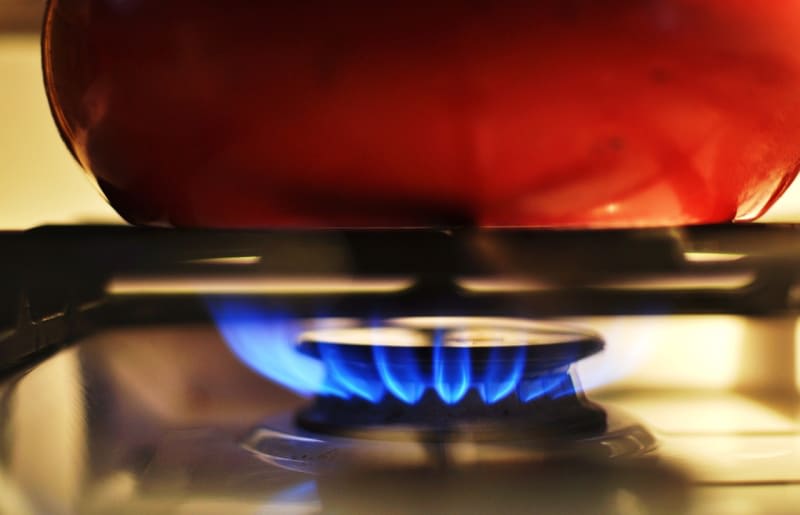Using a gas range or a gas burner often brings intimidation. All it takes is a moment to learn how to work the flames and get the stove hot and ready to use.
In simplest terms, to use a gas stove – push in the burner knob toward the light position, wait for ignition, then adjust it to the heat level (high, medium, or low) that you prefer.
In this article, talk about tips and things to never ever do with gas!
How to Use a Gas Stove Safely?
Knowing the proper use of a gas stove is the finest way to cook. Anyone who uses a gas stove to cook will assure you that it can be used easily.
- Put your skillet or pan on the burner that you wish to use. Push the control knob of the burner in, and then turn it towards the ‘light’ position. This should ignite the flame. In case of no ignition, turn the knob 0ff and entirely to the left.
- Then attempt once more. If the flame does not light, stop and turn the knob off. It will prevent any accumulation of gas inside your house.
- Quickly rotate the knob to the left when the flame gets lit, but not quite all the way – as it would turn off the flame. Adjust the stove knob to the flame height or temp setting that you desire.
The more the flame, the higher the temperature will be and the quicker you will have foods cooked. While adjusting the knob, check the flame visually.
- Keep the oven heat to ‘Low’ when you use a stove for the first time. Use a cooking spray or butter for cooking, so as to prevent the burning of foods.
Cooking is very fast on gas ranges, and it is easy to have foods get burned until you are adjusted to how the burners work.
- When you have finished cooking, immediately turn the flame off. Rotate the oven’s control knob completely towards the left. Remember to turn it as far as possible to the left to prevent any leaking.
What types of fuel can a gas stove use?
A gas stove can work with propane or natural gas. This is a different fuel resource than electricity.
Even professionals love to use these stoves. You can find them being used in hotels, restaurants, eateries, and other places.
Are gas stoves hotter than electric?
A gas stove is not always hotter than electric, but it does heat more evenly and the heat is consistent over time meaning when you turn the flame off, the heat goes off.
Are gas stoves dangerous?
Natural gas-burning stoves and furnaces found in millions of US kitchens and basements can produce a range of health-damaging pollutants, including particulate matter (PM), nitrogen dioxide (NO2), carbon monoxide (CO), and formaldehyde.
Source https://qz.com/1941254/experts-are-sounding-the-alarm-about-the-dangers-of-gas-stoves
The distribution of heat with gas stoves is more uniform than that of electric stoves. The heat is distributed more precisely and accurately.
How to light a gas stove manually?
On marco.org, he says this for how to light a gas stove manually:
- Turn gas on medium.
- Light match. Hold very close to the holes in the center of the burner that fire usually comes out of.
- Wait for full ignition. This should happen within about 3 seconds, and the burner should quickly light all the way around in a neat little ring-closing pattern.*
- Remove your match-holding hand (and the match) quickly.
* If this doesn’t happen within 3-5 seconds, turn the gas off, wait a few seconds, assure anyone else in the room that the gas smell is normal, and start over.
Source https://marco.org/2009/06/03/how-to-light-a-gas-stove-manually
The Gas Stove – A Complete Overview
The stove top is the spot where you have to put the pot/pan on. Do not directly put your foods on the space, since a fire or flame for these stoves come out from the sides.
How does a gas stove work?
Gas stoves today use two basic types of ignition sources, standing pilot and electric. A stove with a standing pilot has a small, continuously burning gas flame (called a pilot light) under the cooktop. When the stove is turned on, this flame lights the gas flowing out of the burners.
Source https://en.wikipedia.org/wiki/Gas_stove
In case you are unable to light your stove, shut it off. If the stove cannot be lit and stays on, there will be an accumulation of gas – which can be harmful.
There is a black line, which shows the stove’s present state. In case you use a burner you are not familiar with if you want to ensure that food does not get burned up, use lower heat settings.

Benefits Of Using A Gas Stove vs. Electric
Although cooks at home do not need the same level of performance as professional chefs, they might find using a gas stove to be more convenient to work with.
More reliable results when compared to electric ovens
Gas stoves are cheaper to run, although the expenses still depend on the prevailing fuel prices.
It is slightly costlier to purchase and set up gas stoves, but some people feel that the expenses are worthwhile keeping the long-term savings in view.
There is more control over the operations of a gas stove. Once you make adjustments to the temperature, the stove immediately changes instead of taking time to get cold or heated up – unlike an electric range.

Heating with gas can definitely come in handy when baking cookies because of the consistency.
Two advantages to consider
A big advantage of using a gas stove is the fact that these work even when there is a power outage, which benefits those living in areas without a reliable supply of power.
Another advantage of is cleaning them. Since they use direct heating, you can scorch the oven to help it wipe clean.
Precautions While Using the Gas Stove
Although gas stoves are easier to operate, you need to be mindful while using them and take some safety precautions to keep your health and that of your loved ones’ safety.
Check the stoves on the regular for gas leakage
You need to check the stoves regularly for any leakage of gas and fix any parts that appear to be rusty or old.
Also, you’ll need to be careful to prevent the spillage of foods or even getting the pan on the fire.
Use a fire extinguisher rather than trying to put the fire out with water.
Turn off the gas if you smell it or hear a hissing noise
If you smell the stinky smell of gas or find a hissing noise, and are not able to locate the source of leak/sound, turn your cylinder off from the source. Open all the windows and get out of your house. Always make sure the knob is off to make sure the valve is closed if you aren’t using your stove.
You can always call the local fire department for an inspection if you aren’t comfortable
Do not forget to light the burner immediately after turning the gas on. It might lead to an mini-explosion in case you wait for 1 – 2 seconds, and someone is near the stove at that time.
Pots and pans must be of a similar size to the burner, not smaller. Also, adjust the burner so that there is no flaring up in the area on the outside of the cookware.
If you are having fatigue, nausea or headaches, leaking gas could be the cause. Get in touch with the gas company or fire department immediately and have the stove inspected.
Carbon monoxide is a harmful gas and can lead to serious health issues or even death. Keep your stove clean for gas to burn the best.
When cooking foods, ensure that the cookware handles are not hanging over the stove. This is because small children may attempt to grab the handles, and get severely injured in the process.
How To Use The Gas Stove In The Kitchen
Gas stoves make the temperatures in kitchens hotter. You will find the kitchen getting a little warmer due to heat loss from the stove, which is also a common issue with electric stoves.

